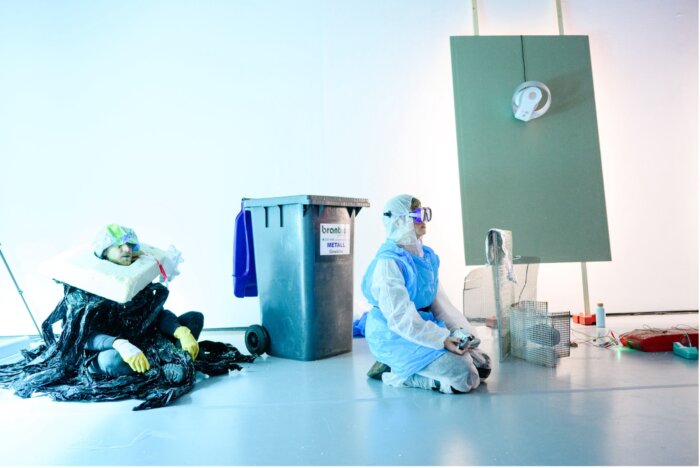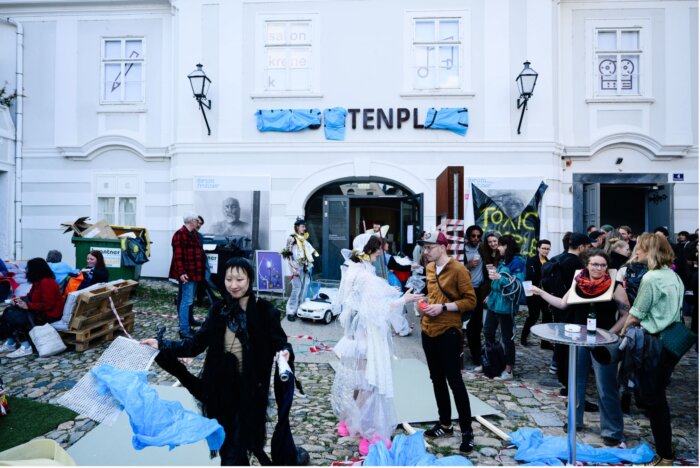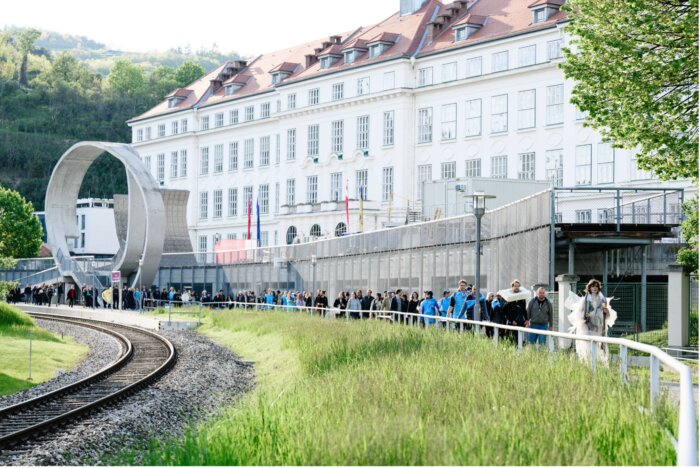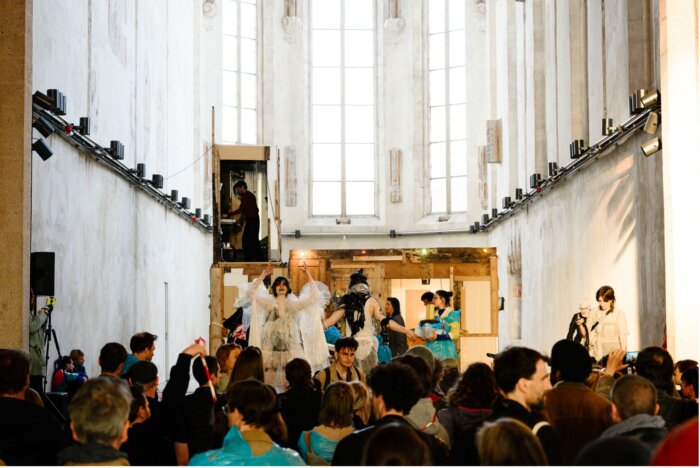Trash as a Means of Religious Communication
Warm Greetings to the General Heathen Public from the Toxic Temple

Trash inhabits an ambivalent, almost contradictory discursive place in our society. On the one hand, ‘trash’ is what we consider not-worthwhile, ephemeral, and uninteresting. Movies, novels, or other products regarded as ‘trash’ are believed to contain little of lasting value—one might enjoy consuming them, but they will have no historic or cultural impact. Similarly, in consumer goods, ‘trash’ is often what is wrapped around the desired product, protecting one’s purchase from the outside world; once its seal is broken and the product obtained, its packaging loses all value. When you rush into the supermarket to pacify your bodily needs—buying a premade sandwich, for example—what encloses your desired good hardly registers your attention; you tear the plastic open and gulp down the sandwich, noticing little about the wrapping before you dispose of it in a nearby trash-can. …That is, you would act that way if you were still what we of the Toxic Temple [1] consider a ‘heathen’: somebody who has not yet recognized our modern consumer trash as communication with the afterlife, and every act of disposing of it as a prayer to eternity.
Whereas within a still-majoritarian, individualist consumer logic of heathens, trash is ephemeral and epiphenomenal, from a larger-than-human, geological point of view, trash is what will outlive us. Trash is the durable and lasting element of our consumer culture. The plastic wrapping of my sandwich will leave traces on the face of the Earth for almost infinitely longer than the time I spent enjoying my sandwich, longer than the time my meandering intestines took to digest it and shit it out again, even longer than it will take the body that once held these intestines to decay and decompose, next to the shit that I produced as long as I was alive. In the Toxic Temple, we try to reconcile our lost ways of ecocidal modern consumer life with these cosmological consequences: we whisper humble prayers when we bid farewell to the plastic container of our frail organic nutrition—solemnly admiring the longevity of its material and the long-lasting effects it has on the order of the cosmos turned chaosmos.
What heathens consider ‘trash’ in fact embodies our culture itself—in all its achievements and failings—for far longer than do the human bodies and minds that are conventionally considered to be the agents of cultural production. This circumstance is not even new or unique to modern consumer society: much of what we know from ancient civilizations like the Roman Empire or the Han Dynasty is derived from their own ancient trash sites. From broken clay pots, fossilized food remains, bones, and teeth, archaeologists can deduce so much information about the everyday life of our ancient forebears. Without trash, we would only know about the kings and emperors who vainly erected statues and mausoleums for themselves but wouldn’t know how life actually looked like for the average citizen. How, for millennia, those statues seduced frail human heathens to believe in vain stories of patriarchal anthropocentric human power, agency, and empire! In what they call ‘trash’ lies true wisdom, deep knowledge, and spiritual connectedness with the troubled matter of facts. The Toxic Temple is humbly devoted to opening up such pathways to more lost heathen souls and freeing the Earth of its humanistic hubris by honoring those eternal wrappings of plastic and nuclear waste that we brought forth.
Because what is new about the late modern era that we currently inhabit is that even most heathens are—to a degree—conscious about this geological communication we send into deep time by means of our trash. To our knowledge, the ancient Romans or Chinese didn’t dwell much on the thought of the consequences of their waste for the afterlife. But in the era some of us vainly call the ‘Anthropocene,’ this pondering becomes one of the major worries of human societies. Humans are recognizing themselves as a geological force. Whether in late-patriarchal euphoria of finally achieved grandeur, or in apocalyptic shock about the catastrophe we are bringing upon ourselves with seeing eyes, modern society is characterized by a rising consciousness of our deep time-impacts on the geological strata of the Earth. We know that we are sending billions and billions of tons of trash into the future. We know of the lasting, toxic effects of these trash items, be they plastic, cement, or nuclear waste. In that order, we are sure that these kinds of trash—that seem central and unavoidable to modern consumer comfort—will outlast us humans for millennia. Microplastics decompose in about 300 to 500 years. While some of the more optimistic moderns might hope that we as a civilization might yet outlive the plastic waste we produce now, it is almost certain that the nuclear waste we leave behind, by hiding it—in the best cases!—deep in the bowels of the earth, will mark the face of the planet for much, much longer than we will do. Conservative estimates say that our nuclear waste will remain (toxic) for 100,000 years. Others expect it to last for millions of years. In a way, we can say that our waste communicates with the far, far future. We speak with the human afterlife by means of our most toxic trash.

While this epochal, mind-boggling realization can be assumed to be superficially established among modern humans, its deep drives and psychological consequences are hardly digested. We know we have a problem but we don’t seem to understand and feel it—at least as long as we remain heathens. Thus, heathen humanity appears incapable of finding any durable, sustainable solutions or approaches to the problem, and becomes deadlocked in what Donna Haraway calls “The Great Dithering,” marked by a mix of apocalyptic anxiety, cold panic, defeatism, and hedonistic nihilism. [2] It is one of the foundational beliefs of the Toxic Temple that we must overcome this insufficient digestion of our geological, transcendent communication with the far future. We need to cultivate and embrace this often ignored but central circumstance that late consumer societies are communicating via trash with the afterlife, and investigate the hidden and sometimes dark desires that make us want to poison the soils and waters for millennia in order to speak with those that will prevail. Only if we come to grips with our toxic transcendent desires may we hope to flourish in the future.
What is the Toxic Temple, you ask? It is a religion to which I want to convert you, dear reader, and this essayistic, semi-scientific style by which I approach you is only a camouflage I employ for the greater heathen public I seek to win as adherents of the Toxic Temple. I am a missionary. But, so as not to irritate your undoubtedly secular-leaning mindset with too much, too soon: on with the text!
Perhaps the field of human culture that has thus far contributed the most to this cosmo-analytical digestion and cultivation of our deep-time communication via trash is the small but significant research field of so-called Nuclear Semiotics. This branch of science was inaugurated in the 1970s when the first concrete designs were considered for disposal of our atomic trash. [3] Since it is too dangerous to use rockets to simply shoot the radiating waste into the sky, the best-practice solution was established of building massive cave systems hundreds of meters below ground level in extremely stable geological stone configurations. In these tunnels, nuclear trash is hoped to be contained without geological interference (e.g. drifting of continental plates, earthquakes, volcanoes, etc.) for the hundreds of thousands of years required. [4] Alongside the engineering challenge of building and maintaining such tunnels lies perhaps an even more difficult challenge: how do we prevent intelligent lifeforms—human or non-human—from actively wanting to enter those caves? How do we warn them about a danger as abstract as nuclear radiation? These are the questions that Nuclear Semiotics devotes its research to—and the scope of these questions is almost too vast to be even understood.
Consider, here, that the oldest signs of writing that archaeologists can (with difficulty) decipher are only about 5000 years old. Language and writing develop over decades and centuries until they are no longer recognizable to our forebears. How can we make sure we can find a writing and coding style as well as the appropriate signs that can communicate for a minimum of 20 times longer than any reference material we have from human semiotic history? What signs and words could last as long as 100,000 years? And even if you could find those words: how would you warn “them”? Because: who are “they”? How much knowledge about nuclear physics can you presuppose when talking to your average descendant in 80,000 years? Or the frog or octopus that managed to evolve into the most intelligent species in the meantime?
It is perhaps no wonder that many of the proposals developed by researchers of Nuclear Semiotics—among whom you can find linguists, physicists, theologians, geologists, and even renowned Sci-Fi authors such as Stanisław Lem—use religious symbolism and tactics. Next to the genetically modified cats that change color when exposed to radiation [5] or artificial moons sending information they are venerating, [6] the establishment of a “nuclear priesthood” [7] that forms like a cult around the secret knowledge of the toxic trash we buried a long time ago is one of the most well-known propositions. It seems to be logical that spans of time so long that they seem like eternity to the human eye require vocabularies and tactics from the field of human culture that is commonly devoted to eternity: religion. One of the central pillars of almost all human religions—and certainly of the Abrahamic religions now adhered to by the majority of religious humans—was always the care for eternity. In the Abrahamic understanding, the divine heaven was considered to be eternal, a wonder to which life on this earth with our frail decaying bodies is only a sad, ephemeral prequel. Most religions offer a communicative connection to some variant of these eternal heavens by means of prayers, sacrifices, orgies or other rituals. We of the Toxic Temple ask: is our relation to our trash—be it plastic or nuclear—not of a similarly religious nature? Do we not—perhaps secretly and without acknowledgment—seek to get in touch with eternity when we dispose of our plastic waste in the environment or bury nuclear trash? The Toxic Temple is devoted to this intuition and seeks to establish meaning and sense where most secular-leaning, perhaps nihilist readers of this journal are currently lacking it.
Most heathens today would claim that our societies are secular. At least in Europe, wherein this text was written, but also in many other parts of the world, religion does not play the important, all-encompassing role in the functioning of society as it used to. Even if those heathens themselves would practice services in some primitive belief system like Christianity, Islam, or Judaism, they would usually want their bureaucratic state apparatuses, social institutions, and economic systems to be based on rationality and efficiency, not religious bias. Your personal belief is considered to be your own choice and freedom, almost like a hobby, but few moderns base their understanding of the world—their cosmology—solely on the dogmas and books of their beliefs. With the birth of democracy, enlightenment, emancipation, and consumer culture, the moderns largely believe that they have freed themselves from religious or spiritual interpretations of the world and rather rely on (a belief in) scientifically established facts and a secular order of society. Curiously, this development is linked to the circumstance that our comfort and life expectancy is higher than it was ever before in human history. Per Michael Serres: [8] over the longest span of history, pain, hunger, and suffering used to be the norm for most humans; now, we of the modern privileged bubble live in circumstances that most of our ancestors might have deemed paradisiac: the most exotic fruits and foods are available in their most beautiful shapes (almost resembling Platonic ideals), wrapped in materials that ensure their longevity, just around every corner. Light and clarity are always available to us by means of a simple switch, and we travel and communicate in speeds we once believed to be reserved only for gods and angels.

It is thus unsurprising that fewer and fewer people find comfort and credibility in the old religions, which promised such spoils only after a painstaking life in the immanence of the Earth in a post mortem transcendent sphere. Many of these promises now—to overstate it only a bit too much—can be delivered by any supermarket. One might claim that the once-transcendent heaven became immanent: heaven is something produced by consumer capitalism. However, where eternity used to be understood as heaven’s most radiating element, we now come to see that its eternal longevity is the most problematic trait of this paradise—even and exactly because it is radiating.
Trash will outlive us all—it is here to stay much longer than we are. It thus can be understood as the modern, superficially secular prayer to the human afterlife. But what are we telling our ancestors with the gigantic heaps of trash we release into the oceans, bury in our mountains, and hide in the underground? We of the Toxic Temple sense that there is still a confusion, or, rather, a lack of profound reflection and cultivation, around this obvious, and—from a geological and cosmological perspective—central element of our culture. It is about time we cultivate and develop it, particularly because our societies might in fact only appear secular and non-religious on a superficial level. We of the Toxic Temple believe that our relationship—yet brute and uncultivated—to the most long-lasting trash we leave behind can only be understood and at the same time tamed as a form of religious communication. And this is why the Toxic Temple was founded and invites you to join our cause: to experimentally give you a room for the expression, cultivation, and veneration of a transcendent desire we moderns clearly seem to be having—although few heathens yet appear comfortable to speak about it or even seem to be able to understand it for themselves. The Toxic Temple is there for you to embrace your most dirty and wasteful desires!
In this approach of a cultivation of our relation to trash by means of religion, we are centrally inspired by the work of poet and philosopher George Bataille, and the minoritarian stream of what could be called “Bataillean ecology.” [9] Ecology today is mostly associated with scarcity, frugality, limiting yourself and ‘doing your homework.’ Excess, joyful wasting of energy or materials seems to be the antipode of it. However, with Bataille, we believe that this approach to ecology and the biosphere is hugely problematic and—without being aware of it—tainted by the old religious idols of Puritan Christianity. In his book La Part Maudite (translated as “The Accursed Share”) from 1949, Georges Bataille shows that most human civilizations had a cultured and sophisticated place for wasting energy and producing trash as part of their rituals and value systems. [10] Be it the potlatch, the orgy, the carnival, or any other ritualistic feast of excess, humans for most of their history had a civilized, ritualized means of wasting energy and trashing themselves. Bataille goes as far as to link this cultural tendency to excess with a general trait of life on Earth: according to him, all life—from the smallest cellular structure to the biggest symbiotic relations—basically consists of two kinetic movements: taking energy in and disposing of it again, breathing in and out, eating and shitting, fucking and dying, bathing in the sun and taking a life, etc. According to Bataille, this basic relation of life only gets lost in Puritan Christianity during the rise of Capitalist Modernity: for evangelical Protestants everything devoted to the second vital movement—that of wasting energy—becomes a taboo. Be it sex, shit, piss, or dying—all of them become more and more disdained and hidden from the public during the rise of capitalism. You die hidden from the public; you have sex only for reproduction; and shit, piss, and assholes all become so negatively connotated that they are used as words of abuse.
With this analysis, Bataille further develops Max Weber’s famous The Protestant Ethics and the Spirit of Capitalism from 1904 to include this hostile attitude towards anything that is excess: the medieval carnival, the orgies, and all other joyful and wasteful celebrations become replaced by silent meditation on one’s eternal condemnation, and one’s most efficient market behavior to redeem oneself. [11] It was only this mindset that enabled capitalism with its mania on market efficiency and turning everything into a productive undertaking, according to Bataille. In this vein, Bataillean ecologists would argue that a one-sided focus on recycling, energy saving, and increased efficiency—as they are purported in mainstream (and capitalist) ecology today—is still a variant of this Puritanical heritage: you still feel essentially doomed and condemned by your wasteful spoils on the frail, ephemeral Earth, and thus you try to do as little harm as possible, tread lightly, and perhaps even pay off your sins by means of ‘compensation.’ The chemist and designer Michael Braungart argues that this essentially Christian attitude to ecology is not only not enough, it actively prevents action—by understanding our ‘ecological footprints’ as purely negative (we try to minimize these as much as possible), we are kept from trying to seek a positive, mutually beneficial relations to our eco-systems. [12] Furthermore, any collectivizing spirit required for political action has a hard time if it can only express its demands ex negativo: we should do less, emit less, etc.—not the best rallying cries to start an inclusive movement. As some of the images that accompany this missionary gospel illustrate: we of the Toxic Temple create spaces for ritualistic joy-taking in the excess quality of our ecologically disastrous lifestyles in order to link up with a vital property of life on Earth: taking joy and space in wasting and trashing!

But Bataille’s analysis goes even further than these critiques: he argues that the societal hindrance and tabooization of the necessary wasting of trash and energy actively produces catastrophe. Bataille wrote La Part Maudite during the Second World War and before ecology became an established science or a political movement. This is why he focuses his analysis on the Second World War, which he speculatively explains to be a result of the inherent holding back of the excess energy and waste that capitalism produces in its normal flow. Since the 20th century saw the globalization of the world to market efficiency, Bataille remarks that the—for him—necessary emission and disposal of energy got retained and dammed up to a degree that it sooner or later had to burst in an excess of energy. Since, according to Bataille, almost all societal, civilized, and cultured outputs for this vital excess have been closed off and destroyed by the puritan rationale, the amassed energy periodically has to erupt in cataclysms of senseless destruction—for Bataille: wars.
This cosmo-psychological explanation is, of course, hugely speculative but it aligns well with psychoanalysts’ insights such as Julia Kristeva’s Les Pouvoirs de l’horreur, who shows that there slumbers a vast, uncontrollable energy in what is culturally defined as the ‘abject.’ [13] For Bataillean ecologists, this analysis could even serve as a critique of mainstream ecology: perhaps the contemporary move to make everything recyclable and more efficient can be understood as a further radicalization of the Puritan spirit of now green-washed capitalism that essentially still produces the same catastrophic long-term effects.
We of the Toxic Temple could thus argue that we need not become even more efficient with our trash, but much rather the contrary: we must find more joyful and cultured outlets and rituals for producing trash and wasting energy. Instead of feeling inherently bad about a normality that still produces way too much toxic waste and consumes excesses of energy on an everyday basis, we could try to actively take joy in what drives us to produce trash and devote temples and rituals to this form of excess. It is the hope of the Toxic Temple that this taming, civilizing, and cultivating of our vital lust for trashing, wasting, and excess might be more productive to bring about the radical transformation we need than the currently prevailing calls for treading lighter, consuming less, and feeling guilty about it all. The Toxic Temple thus is a small and humble undertaking of cultivating our relation to trash by investigating our transcendent desires in wasting and building rituals according to our lust for trashing. It is a socio-cultural experiment of finding radical solutions for the catastrophic situation we find ourselves in. So far we have created Toxic Temples at art festivals that were at the same time places of veneration and experimentation as well as places of conversation and conversion for despairing heathens. We have offered confession booths to overcome guilt and take responsible joy in ecocidal behavior. We have invited heathens to familiarize themselves with the matters that carry modernity—plastic, oil, motors, aluminum and others—and regard their power as growing out of their own misguided spiritual desires.
The first two images were taken during a ‘Holy Mess’ in which we create a transdisciplinary and multi-sensory “performance” (according to the booklets of the art festivals) that interactively and somatically made us feel our metallically radiating, plastic footprint on the Earth. [14] Heathens were only permitted to enter the Temple “properly dressed,” meaning in blue plastic trash bags. The next images are preaching the heathen mass of art-loving bobos (“bohemian bourgeois”) into a frenzy of religious fundamentalism. [15] We decried the injustices of being put into the boxes of ‘mere art’ and ordered our young adepts to storm a nearby temple of an old primitive belief with us: the Dominican Church of Krems. The last images show us in the reclaimed church while bringing a righteous mess into the transcendent temple of old, adorning the heathen idols with those that really outlast. These are just a few examples of the vast array of practices and rituals that we continue to develop. If we have sparked interest in your empty heathen soul, you can listen to our gospel on the high-frequency radio waves [16] and start whispering small prayers the next time you light an SUV on fire or throw a plastic bottle into your nearby river. Think joyfully about where the bottle will travel and stand witness to your frail existence long after your smallest particles have been washed away by the same waves. Look up in humble joy to the pillars of smoke your burning car sends to the heavens to ever more obscure primitive angelic visions and demonstrate to even the sternest heathen soul that they need no longer look up, because heaven has come (crashing down) to earth. And is there to stay on it—into eternity, shimmering and radiating in the bright colors of what we call the “Better Nature”!
We thank the journal On_Culture for taking on this monumental task of reflecting about the cultural implications of ‘Trash’ and the possibility to present our religious undertaking to an educated heathen community that seeks meaning in their trite modern existence. If you want to learn more about the Toxic Temple and the rightful way, get in touch with us to develop your own toxic rituals or get our book—it is wrapped in beautiful, long-lasting cellophane!

_How to Cite
Kilian Jörg. “Trash as a Means of Religious Communication: Warm Greetings to the General Heathen Public from the Toxic Temple.” On_Culture: The Open Journal for the Study of Culture 17 (2024). <https://doi.org/10.22029/oc.2024.1451>.

_Endnotes
- [1] Kilian Jörg and Anna Lerchbaumer, eds., Toxic Temple – An Artistic & Philosophical Adventure into the Toxicity of the Now (Berlin/Boston: de Gruyter, 2022).
- [2] Donna Jeanne Haraway, Staying with the Trouble: Making Kin in the Chthulucene (Durham: Duke University Press, 2016), 144.
- [3] For a good overview of the historical research on nuclear semiotics see Frank Böckelmann, Susanne Hausner, and Roland Posner, Warnungen an die ferne Zukunft: Atommüll als Kommunikationsproblem (München: Raben Verlag, 1990).
- [4] The first and so far only site for permanent nuclear waste disposal is Onkalu in Finland which is expected to start operations in the next years. Watch the highly recommendable documentary Into Eternity, directed by Michael Madsen (2009; Finland, Sweden, Denmark) to learn more about it and Nuclear Semiotics.
- [5] Françoise Bastide and Paolo Fabbri, “Lebende Detektoren und komplementäre Zeichen: Katzen, Augen und Sirenen,” Zeitschrift für Semiotik 6, no. 3 (1985): 257–264.
- [6] Stanisław Lem, “Mathematische Kodierung auf lebendem Trägermaterial,” Zeitschrift für Semiotik 6, no. 3 (1984): 253–256.
- [7] Thomas Sebeok, “Die Büchse der Pandora und ihre Sicherung: Ein Relaissystem in der Obhut einer Atompriesterschaft,” Zeitschrift für Semiotik 6, no. 3, (1984): 241–249.
- [8] Michel Serres and Bruno Latour, Eclaircissements: cinq entretiens avec Bruno Latour (Paris: Flammarion, 1994).
- [9] Ray Huling, “Bataillean Ecology: An Introduction to the Theory of Sustainable Excess,” Moveable Type 11 (2019): 25–37. Doi: 10.14324/111.1755-4527.096.
- [10] George Bataille, La Part Maudite (Paris: Les Éditions de Minuit, 1919/1967/2014).
- [11] Max Weber, The Protestant Ethics and the Spirit of Capitalism (Oxford: Oxford University Press, 1920/2010).
- [12] Michael Braungart and William McDonough, Intelligente Verschwendung: The Upcycle: Auf dem Weg in eine neue Überflussgesellschaft (München: Oekom Verlag 2014).
- [13] Julia Kristeva, Les Pouvoirs de l’horreur – Essai sur l’abjection (Paris: Éditions Seuil, 1980).
- [14] Donaufestival, Program-Booklet 2023, (Krems/Donau, 2023).
- [15] Donaufestival, Program-Booklet 2023.
- [16] Kilian Jörg and Anna Lerchbaumer, “Toxic Temple,” Radiokunst – Kunstradio, February 14, 2021, <http://kunstradio.at/2021A/14_02_21.html>.


